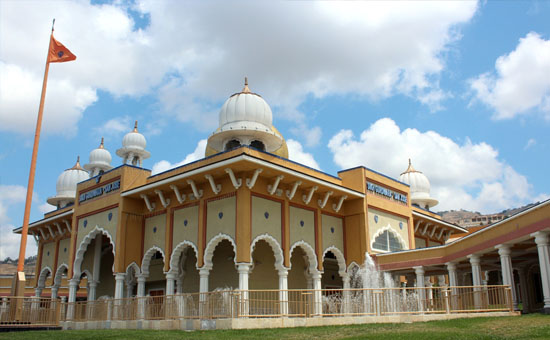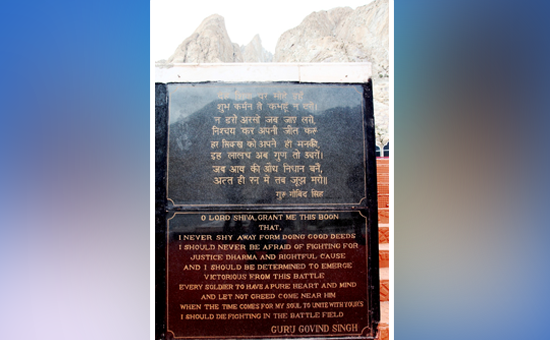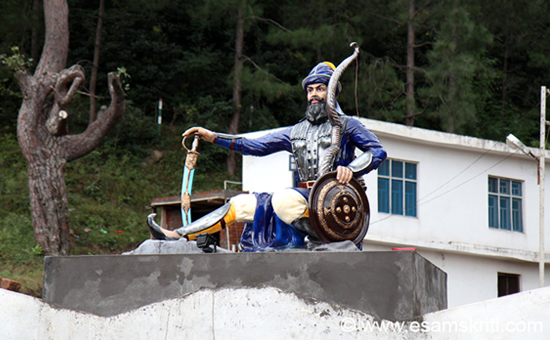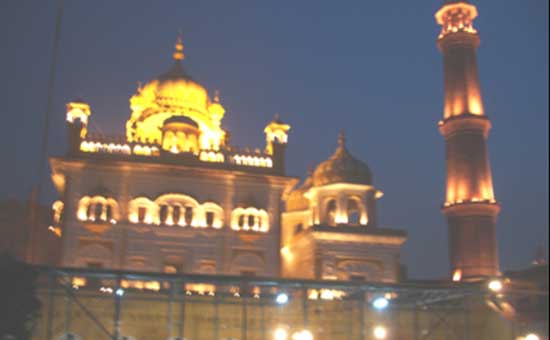- This article examines the claim of Sikhs
saving Hinduism by covering the life of each Guru. Read and decide.
During the recent farmer protests, some Punjabi Sikhs stated on Twitter (for eg. H Sikkha tweet)
that Hindus should be grateful to them because Sikhs saved Hindus and Hinduism.
I was taken aback for two reasons.
One it has no relevance to the farm bills,
because these farm laws are not a Hindu Sikh issue. Two, even if Sikhs saved
Hindu lives, say 250 years ago, what relevance does that have with the farm
laws of today.
This goaded me to read and ascertain whether Sikhs saved Hinduism. Born in a Punjabi family, we were brought up to respect Sikhs but reason for respect was surely not because they claimed to have saved Hindu lives. Ma’s Dadi and Nani were both Sikh ladies. But then, contemporary distinctions between Hindu and Sikhs did not exist.
This article seeks to examine the claim of
Sikhs saving Hinduism. It covers life of each Guru, Banda Bahadur and Ranjit
Singh and is based on reading of The History and Culture of Indian People by
the Bharatiya Vidya Bhavan Volumes 6-8, The Sikhs of Punjab by J.S. Grewal and A
History of the Sikhs by Khuswant Singh.
About Sikh
Gurus
The Muslims of Central Asia invaded and
ruled Punjab for nearly five hundred years prior to the birth of Guru Nanak in
1469. Forcible conversions, destruction of temples were some of the miseries
that Hindus faced.
1. Guru Nanak (1469-1539), child of Kaluchand and Sulakshana Devi, Khatri)
He was a witness to the treatment meted
out to the people of Punjab by Babur in 1521. Thousands of people were
massacred and taken prisoners. The barbarous treatment of prisoners including
women broke the tender heart of Nanak. Volume
7 pg. 306.
Nanak laid emphasis on Nam Japo
(singing the praise of God), Vand Chako
(eating together) and Kirt Karo (work
and earn, then with his hand gives some away).
Nanak called his religion Gurmat or Guru’s wisdom. This word occurs in Guru Nanak’s hyms more than two hundred times. The public called his followers Nanak Panthis. His disciples called themselves Sikhs from “Sanskrit word sishya meaning a learner or a person who takes spiritual lessons from a teacher.” Volume 7, pg. 659.
2. Angad or Bhai
Lahna Trehan (Guru from 1539-1552, Khatri)
Before he died Nanak nominated a Kshatriya, Guru Angad as his successor. Angad started collecting Nanak’s hymns which were written in Lande Mahajani, in a rather rough/crude script. To avoid their misinterpretation, Angad decided to beautify the Lande alphabets to give birth to a new script called Gurumukhi
meaning that which came out from the mouth of the Guru.
3. Amar Das
Bhalla (Guru from 1552-1574, Khatri)
Guru Angad nominated a Kshatriya as his
successor. Guru Amar Das was against torturing the body and the purdah system. From here onwards gurudom became hereditary.
4. Ram Das
(Guru from 1574-1581, Khatri Sodhi)
He added to the growing solidarity of the
community with a sacred tank in the city of Amritsar, earlier known as
Ramdaspur or the town of Guru Ram Das.
5. Guru Arjun
(Guru from 1581-1606)
Born in 1563 Guru Arjun was an original
thinker, illustrious poet, philosopher, and organizer. His greatest achievement
was the compilation of the Adi Granth in 1604.
For helping Khusrav, the rebellious son of
Jahangir, with money the Guru was tied in the burning sun over hot sand and
tortured in June 1606. Exhausted under its impact he collapsed under the strain
and died at the age of 42.
This event proved to be a
turning point in the Sikh attitude towards the Mughals. “They resolved not to submit meekly to their oppressions but to defend their rights by arms and thus began the process of transformation of the Sikhs into a military power.” Volume 7 pg. 307.
At that time the Sikhs had no political
consciousness so the question of having any political aspirations did not
arise. Note that the first four Gurus were totally
spiritual and the 5th Guru was martyred by the Mughals. In
his memoir Jahangir called Arjun a Hindu who lived at Govindwal on the banks of
the river Beas. Volume 7 pg. 306.
 San Jose Gurudwara, California.
San Jose Gurudwara, California.
6. Guru Har
Govind (Guru from 1606-1644)
Instructed by his father, he began the
arming of his followers. He hung by his side two swords signifying Miri and Piri. He armed and drilled some of his sturdy disciples. “According to Sikhan di Bhagat Ratan Mala (written
in the 17th century), Guru Hargobind was taught Shastarvidya by two Rajputs, namely Rao Sigara and Rao Jaita.” Source
He built a fort at Amritsar called Lohgarh
and constructed the Akal Takt or God’s Throne in 1609. There he sat on a throne and administered justice like a king in court.
He narrated stories of deathless bravery
while some professional bards sang tales ballads of unrivaled heroism, esp. of
Rajput chivalry.
This was the beginning of the
transformation of Sikhism. With meditation and preaching were added
riding, wrestling and hunting. He established congregational prayers which strengthened
the spirit of amity and cooperation amongst the Sikhs.
Due to this approach the Sikhs came to
occupy a separate State within the Mughal State. This aroused the anger of
Jahangir. He demanded the balance of the fine levied on Guru Arjun. He sent Har
Govind to Gwalior Fort and kept him in jail for 12 years. Some believe he was
in jail for 3 years since six children were born to his 3 wives during the
period of alleged captivity.
His fellow prisoner in Gwalior fort, Raja of Bilaspur offered shelter to the Guru’s family in his State. Guru’s disciples selected a site between Sivalik Hills and river Sutlej and named it Kiratpur. They constructed a building some buildings, and it was here that the Guru returned after his battles with the Mughals.
There is talk of Har Gobind releasing
Hindu kings from Gwalior Fort.
Yogendra Singh wrote
in Pragyata.com, “When Guru Hargobind was released from Gwalior jail in February 1620, he had with him the company of 52 Rajput princes of the Rathore clan. These Rajputs then went on to raise an army of 700 horsemen for the protection of the ruling house of Sikhs.”
ACTUALLY Singh added, “The local Jagirdars of Punjab-who, being unhappy after Guru Hargobind’s release, had struck an alliance with Mughal governor Abdul Khan-attacked Guru at Rohilla, in, what later came to be known as the first battle of the Sikhs. Luckily for the Sikhs and the Guru, Rajputs under Rao Mandan Ji Rathore were standing as the bulwark in between.”
After being imprisoned by Jahangir he
realized the art of diplomacy. This ended with the death of Jehangir. He got
into a fight with successor Shah Jahan and defeated his armies. The Guru was
busy in warfare from 1634 to 1640.
He spent the last two years of his life
converting Muslims to Hinduism. While some people have criticized the Guru for
engaging the Mughals in a battle that could not be won, he was trying to change
the age old mentality of the Hindus of meekly submitting to the oppressor.
Note the fight was between the Guru and
Mughals. In fact it was Hindu Rajputs who protected the 6th Guru.
The next two Gurus, 7. Har Rai (1644-1661) and 8. Har Kishan (1661-1664) have not left much of history behind
them.
 Guru Govind Singh prayer to Lord Shiva at Siachen War Memorial.
Guru Govind Singh prayer to Lord Shiva at Siachen War Memorial.
9. Guru Tegh
Bahadur (Guru from 1664-1675)
He was the youngest son of Guru Har
Govind, the sixth Guru. At that time
Aurangzeb was determined to establish an Islamic State in India and took
various measures to oppress Hindus.
It was during this period that Sawai Jai Singh gifted Gurudwara Bangla Saheb to the
Sikhs.
Why was Guru Tegh Bahadur beheaded?
Locals were forced to convert to Islam in
Punjab and Kashmir (Pandits). In order to infuse courage in the hearts of Hindus
and his disciples he undertook a tour of East Punjab. Some Kashmiri leaders met
to apprise him of their plight. He advised them to inform the emperor, to
convert Tegh Bahadur first and then all of them would embrace Islam.
Aurangzeb was already anti-Sikh. He was
now told that the Guru was infusing the spirit of rebellion among the Kashmiris
and Jat peasantry of Punjab. It was also alleged that Guru Tegh Bahadur claimed
have possessed the power of performing miracles which was opposed to the tenets
of Islam.
Aurangzeb was not prepared to witness
another rising in Punjab (after just suppressing the frontier tribes) so he
decided to teach the Sikhs a lesson and summoned Tegh Bahadur to Delhi.
He reached Delhi with 5 disciples where he
was asked to perform miracles or embrace Islam. The Guru denied that he could
perform miracles and did not embrace Islam. One of his disciples Bhai Mati Das,
was tied to two posts and his body was sawn across from head to loins. Another
was boiled alive. The other 3 fled but the Guru remained firm in his resolve.
He was put in chains and beheaded on 11/11/1675. Volume 7 pg. 316.
So, the Guru
was beheaded because he refused to perform miracles and embrace Islam. Yes the Pandits met him. Whether it was to save Hindu lives is for you to judge.
Do read: The earliest historical accounts of Guru Tegh Bahadur's end and subsequent narratives
10. Govind Rai
later Guru Govind Singh (Guru from 1675 to 1708).
The murder of his father and grandfather,
oppression of Hindus got Guruji fired up to create a national awakening in
Punjab similar to what Shivaji had done in Maharashtra.
While reading the Puranas, the Guru had
been deeply impressed with the idea that Bhagwan had been sending a saviour at
critical times to save and destroy evil-doers. He believed he had been sent for
that purpose. In the Chandi Charitra
the Guru says that in the past God had deputed Durga to destroy the evil doers
and this duty had now been assigned to him.
Birth of Khalsa - At a congregation held at Anandpur on 30 March 1699, after a stirring speech the Guru flashed his sword, and said ‘that every great deed was preceded by equally great sacrifice; the Holy Sword would create a heroic nation after supreme sacrifice. He then asked if anyone in the gathering would offer his head in the services of God, Truth, and Religion.”
The five heads that rose were Dayaram a
Khatri from Lahore, Dharamdas a Jat from Hastinapur near Delhi, Sahib Chand a
barber from Bidar in Karnataka, Himmat Chand Kahar water carrier from Puri in
Orissa and Mohkam Chand Chihimba from Dwarka in Gujarat.
They were designated the Five “Beloved Ones” and termed “Khalsa” (ie Purified). In India 'five' has been a sacred number from time immemorial. Panchon mein
Parmeshwar hai is an old saying indicating the presence of Divinity in
five, as are as the five elements of nature.
According to Khalsa tradition, its
followers had to sport the five Ks i.e. Kesh (long hair), Kangha (comb), Kirpan
(sword), Kara (steel bracelet), Kachcha (knickers). Long hair and turbans were
supposed to protect the face and head from sword cuts and lathi blows. The kara was a reminder that the Sikh
spirit was strong and unbending. The kachcha was more suitable for fighting the Mughals in than the dhotis and loose trousers of the Muslims. The kara was also useful in hand to hand fights and “guarded the vulnerable portion of the right hand which wielded the kripan”. Their salutation was to be Wah-e-Guru ji
ka Khalsa, Wah-e-Guru ji ki Fateh.
It means the Khalsa is Thy Own, O Lord, and so is the Victory.
Then began a series of battles with the
Mughals in which the Guru had often to face heavy odds, but in many cases
victory was on the side of Khalsa. Anandpur was invaded 5 times, the most
serious one in 1704.
In 1704 his two
sons fell into the hands of the Governor of Sirhind. They were pressed to embrace Islam. They refused and were
bricked up alive in the fort wall and beheaded on 27/12/1704.
After relentlessly fighting the Mughals for years, the Guru moved to Nanded, the headquarters of Lachman Das or Madho Das Bairagi, alias Banda Bhadur. Banda was sent to Punjab while the Guru’s wife, Mata Sahib Devi, returned to Delhi.
Meanwhile Vazir Khan of Sirhind was plotting against the Guru’s life. Here he was stabbed by two pathan boys in 1708. Following the practice of Hindu saints, who at the divine call would set in a samadhi and expire, the Guru had prepared a funeral pyre for himself. He calmly walked into it.
Note the 10th
Guru fought the Mughals. Khushwant Singh quoting the 10th
Guru wrote in A History of the Sikhs, “The only reason I took birth was see that righteousness may flourish.” Pg.75 “It was the battle of survival, not only of life, but of ideals. It became a Dharma Yudh.” pg.74 Quotes from Volume 1.
GGS started Khalsa to end Mughal
oppression. There is no reference to saving Hinduism anywhere.
All the Gurus were Khatris but today the community is controlled by the Jaats through the Shiromani Gurudwara Prabandhak Committee. Nanak was a Bedi, Angad a Trehan, Amar Das a Bhalla and the rest were Sodhis.
 Banda Bahadur was born at Rajouri near Jammu.
Banda Bahadur was born at Rajouri near Jammu.
Banda Bahadur
After the assaination of the 10th
Guru, Banda on the instructions of GGS returned to Punjab and collected an army
of about 40,000 Sikhs and overpowered the Mughals in the neighborhood of
Sirhind. Subsequently, the governor of Kashmir, Abdus Samad Khan defeated the
Sikh army and Banda was forced to surrender on 17/12/1715. He was tortured and
died on 19/6/1716.
Khushwant Singh wrote, “Although Banda’s success was short lived, it proved that the peasants were disconnected and administration feeble. In seven stormy years Banda changed the class structure of land holdings in the southern half of the state by liquidating many of the big Muslim zamindars of Malwa and Jullundur Doab. Large estates were first broken into smaller holdings in the hands of Sikh or Hindu peasants. With the rise of Sikh power, these holdings were once again grouped together to form large estates, but in the hands of Sikh chieftains.” Volume 1 pg. 113
Khushwant Singh wrote that post the third battle of Panipat, “Sikhs liberated over 2,000 Hindu women Ahmad Shah Abdali was taking to stock the Afghan harems.” Volume
1 pg. 145.
According to this New York Archives article,
Hindus of Trilokpuri gave shelter to over 600 Sikh women and children during
the 1984 anti-Sikh violence that rocked Delhi. Sunita Premi gave shelter to 30
Sikhs in 1984 in Delhi. Read India
Today report. There are many more examples.
Maharaja Ranjit Singh
Ranjit Singh was brave and a realist. He
knew he could not take on the British so agreed areas that he would control
(not all of Punjab) and focused on defeating the Afghans. To read more about Ranjit
Singh
Between 1767 and 1773, the Sikhs extended
their power from Saharanpur in the east to Attock in the west, from Multan in
the south to Kangra and Jammu in the north. They organised themselves into 12 Misls or confederacies of which Ranjit
Singh father headed one.
Ranjit Singh wanted to bring all the 12
misls under his personal sway. He achieved great success but was confronted
with the power of the British who had extended their power to the Yamuna after
the second Maratha War in 1803-04.
The greatest achievement of Ranjit Singh was the creation of the army. Aurangzeb devastated the dominions of Shivaji but could
not destroy the Marathas who rose out of the ruins to dominate India
during the 18th century. Conversely, the dominions of RS were
destroyed within 10 years of his death.
Also read: Shivaji
and the Rebirth of a Nation ,
The Saga of Raja Shivaji – from Agra to Salher
 Ranjit Singh Samadhi at Lahore.
Ranjit Singh Samadhi at Lahore.
Related Issue
As part of this Sikhs saved Hindu
narrative there have been attempts to undermine the bravery of Khatris (Hindus)
and play up the bravery of Sikhs (Jaats).
Besides Dewan Mohkam Chand, another brave Khatri in Ranjit Singh's team was Misr Dewan Chand. After capturing the forts of Multan and Shujabad in 1818, he was honoured with the title of Zafar Jang Bahadur (victorious in
battle). They are hardly spoken about but another able warrior Hari Singh Nalwa
is remembered. (The name Nalwa, or Nalua was given to Hari Singh when he tore
off the head of a lion). Similarly Hindu
courtiers of Ranjit Singh like Bhawani Das (finance minister), Dina Nath
(financial advisor) and others have not won accolades in public.
In support of their argument of Sikhs
saving Hinduism some quote this verse from the Vachira Natak -
Tilak janjhoo raakhaa Prabh taa kaa|| Keeno bado kaloo maih saakaa||
He protected the forehead mark
(Tilak) and sacred thread (of the Hindus) which marked a great event in the
Iron Age.
Another
verse.
Dharam het(i) saakaa jin keeaa|| Sees(u) deeaa par sirar(u) na deeaa||
For the sake of Dharma, he
sacrificed himself. He laid down his head but not his creed. Source
When the Gurus lived and till say about
1860 the Hindu Sikh distinctions did not exist as it does today. So the Gurus
were saving people of their own community. I believe that modern day Sikhism is
a 19th century colonial construct. To know why read here
If I have missed out on some history,
please write in with details and reference.
To summarize, out of the 10 Gurus, the
first four were spiritual. Fifth Guru Arjun was martyred by the Mughals. The
sixth Guru Har Govind took on the Mughals and received support from Hindu Rajputs.
The 7th and 8th Gurus did not leave much behind. The 9th
Guru Tegh Bahadur was beheaded by Aurangzeb because he did not perform miracles
and embrace Islam. The 10th Guru Govind Singh spent his life
fighting the Mughals and was stabbed by 2 Pathan boys. As quoted above, he
fought for righteousness or Dharma (common to all Indic faiths).
Banda Bahadur was a Hindu Bairagi. Ranjit
Singh gave gold for three temples Hari Mandir, Jwalamukhi Mandir and Kashi
Vishwanath Mandir and wished to donate the Koh-i-noor diamond to the
Jagannath temple, Puri
Actually this bit about Sikhs saving
Hindus is propaganda. I leave it for the readers to decide if and how Sikhs
saved Hinduism and Hindus.
Also read
1. How
the British divided Punjab into Hindu and Sikh
2. The
unbreakable Hindu Sikh bond
3. History
of Sikhs
4. About
Nishan Sahib and Khanda
5. Why
was the First Son made a Sikh
6. Comparing Indic vs Abrahamic Faiths – A Primer
7. Why
Guru Nanak/Guru Goving Singh wore a janeu
8. Langars
by Temples of Karnataka
9. Vijayanagar Empire saved Sanatan Dharma in South India
10. Guru Nanak on Babur Invasion